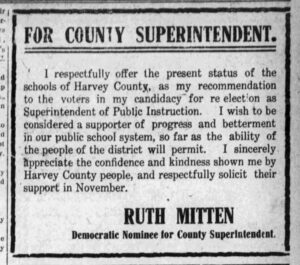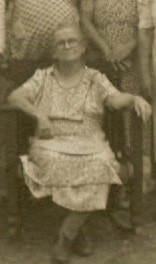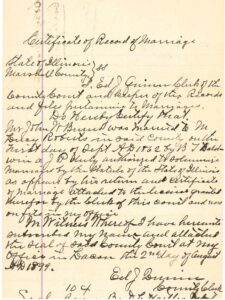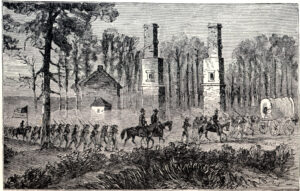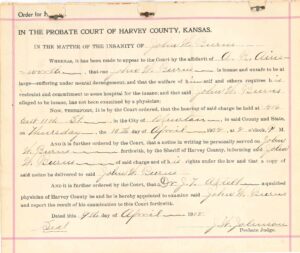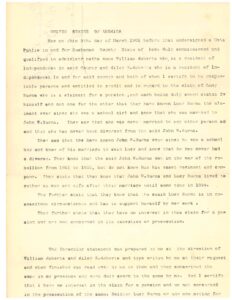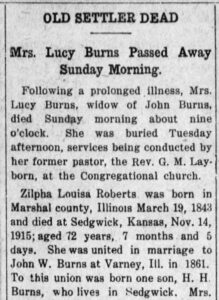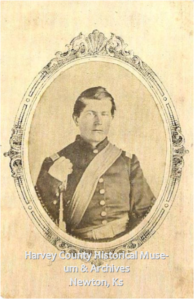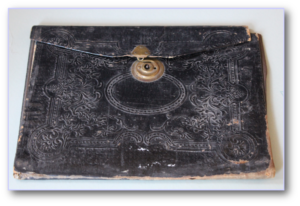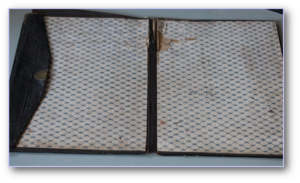by Kristine Schmucker, Archivist/Curator
“The Most Important County Offices”
In advance of the 1910 vote for Harvey County Superintendent of schools the Newton Journal broadly proclaimed, “One of the most important county offices is that of superintendent of schools . . .” Efficiency was highly desired, practical knowledge, executive ability and “a sincere devotion to the work. Above all things the office should not be one with political coloring.”
Who could fill such a position? The editors recommended the democratic candidate, “a young lady qualified in every detail,” Miss Ruth Mitten.
Ruth Emma Mitten was born in Troy Grove, Illinois, in May 1876. Ruth was the fifth child in a family of ten children. She grew up on the family farm and attended local schools. Ruth came from a family that valued education. Her father, J.H. Mitten, a Civil War veteran, served as county superintendent in Illinois and likely provided inspiration for Ruth’s chosen career.
Mitten graduated from Mendota High School, Mendota, Ill in 1894. She continued her education at Illinois Normal University, Normal, Ill and the University of Illinois, Champaign, Ill. While she was educating herself, she was also teaching in local schools.
In 1902, she traveled with her parents, J. H. & Almira Bell Ransbarger Mitten to Harvey County, Ks. Her first teaching job in Kansas was in ElDorado, but after a year she taught in Harvey County schools. The family farm was located 2 1/2 miles east of Newton on 1st Street.
No doubt her father was a source of wisdom for Ruth embarking on her own time as county superintendent.
“Forget Political Affiliations . . . To Vote Right “
The newspaper editor praised Miss Mitten, a Democrat, as highly qualified for the position of County Superintendent noting that “she is thoroughly conversant with school law and requirement . . . possesses that tact and diplomacy so essential in successful school work. She has splendid business judgment and practical common sense.” The editor concluded by urging voters to “forget political affiliations long enough to vote right on this matter.” (Newton Kansan 27 October 1910)
Miss Mitten won the election in 1910. She was reelected in 1912, 1914, and 1916. In 1912, she ran unopposed.
“The Best Years of Her Life”
The A Standard History of Kansas and Kansans (1918) praised Mitten for giving “the best years of her life to educational work and progress.”
As Harvey County Superintendent, she supervised seventy-five schools, 125 teachers and a total enrollment of 5,730 students. Her offices were located in the courthouse.
Mitten was also active in the Christian Church, where she served as superintendent of the junior department. Contributing to the community was also important and she was involved in the Macon Township Grange, the Women’s Christian Temperance Union and several state and local teacher associations.
In 1918, Miss Mitten was appointed to the Education Commission with the National Educational Association. She was appointed by Kansas State Superintendent, W.D. Ross. The Education Commission was to act in advisory capacity to the National organization giving each state a voice, “so that when it [National Educational Association] makes a pronouncement on national education it can speak not for itself but for all of the highest educational interests of the country.” (Newton Kansan 4 July 1918) It was an honor for Miss Mitten to be asked for such a role.
Ruth Mitten resigned from her position on September 1, 1920. The County Commissioners accepted her resignation and appointed Mary Morrison to fill the position until the November election. Mitten served has County Superintendent for five consecutive terms, “having always rendered excellent service and her resignation from that office was receive with regret in the educational circles throughout the county.” The Kansan noted that she, along with her father J.H. Mitten and two brothers planned to travel to Furgis, Montana to visit another brother, J.H. Mitten Jr, at his ranch “for an indefinite time.” (Newton Kansan, 6 August 1920)
Ruth Mitten died November 5, 1942 at the age of 66. She is buried in an unmarked grave in Greenwood Cemetery, Newton, Ks.
Sources
- Newton Kansan: 21 May 1906, 27 October 1910, 15 October 1914, 14 July 1918, 2 April 1920, 6 August 1920.
- “Ruth Emma Mitten.” A Standard History of Kansas and Kansans, written & compiled by William E. Connelley, 1918, transcribed by students from USD 508, Baxter Springs Middle School, Baxter Springs, Kansas, March 13, 2000.
- Photos from L.London on Find A Grave, Ruth Mitten (1876-1942).


